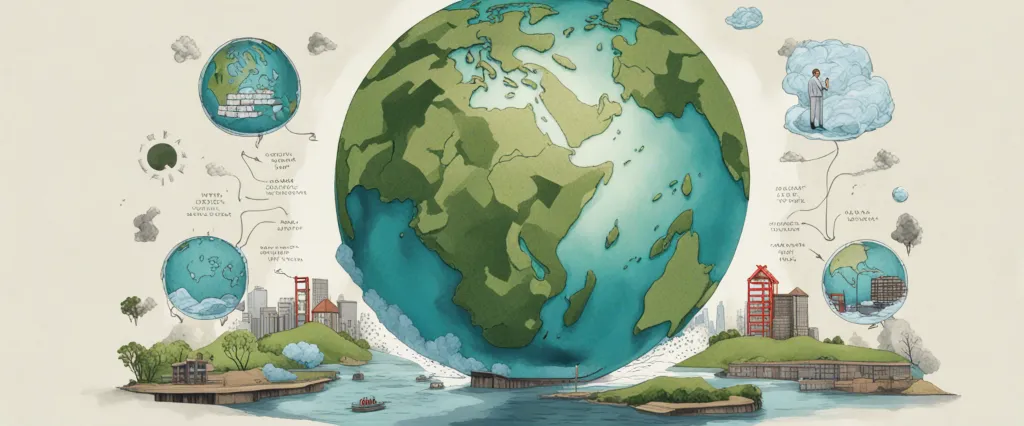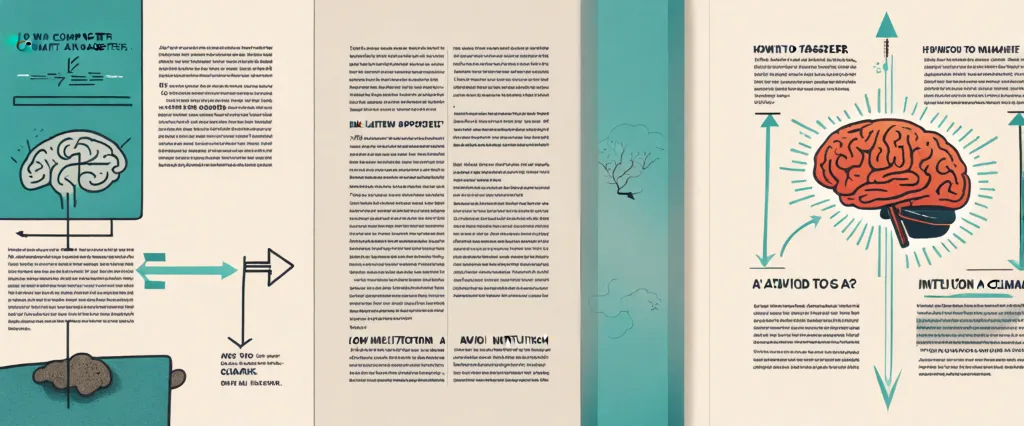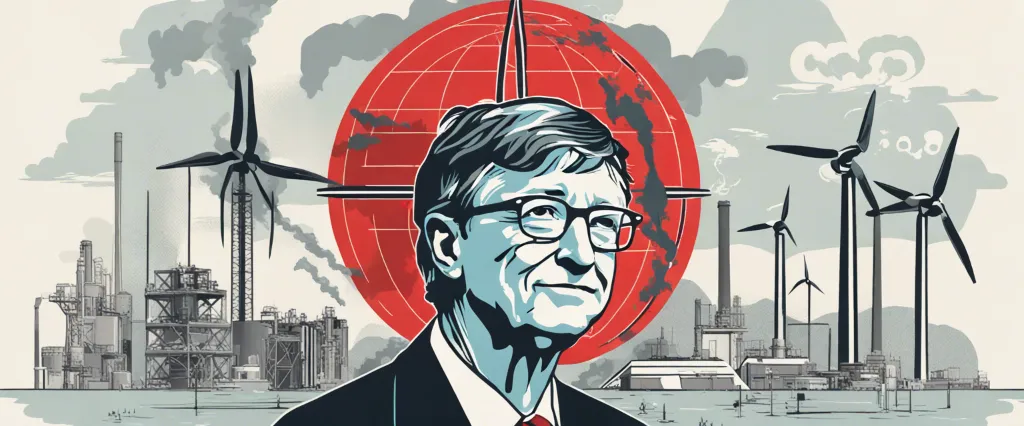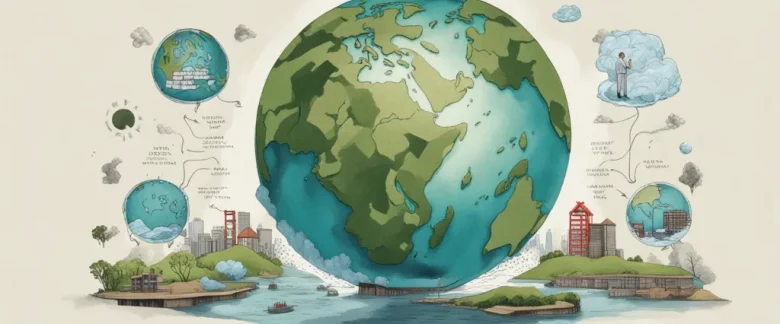
In his groundbreaking book, “How to Avoid a Climate Disaster,” renowned entrepreneur and philanthropist Bill Gates outlines a comprehensive plan to combat one of the greatest challenges humanity has ever faced: the climate crisis. Drawing from his extensive knowledge in technology, energy, and innovation, Gates presents a candid and pragmatic assessment of the current state of our environment, and offers actionable solutions to minimize and ultimately eliminate greenhouse gas emissions. As the co-founder of Microsoft and co-chair of the Bill & Melinda Gates Foundation, Gates brings his unique perspective and deep commitment to tackling global issues to the forefront of this crucial conversation. By combining his visionary thinking with scientific advancements, societal changes, and political collaboration, Gates provides a roadmap for a sustainable and prosperous future for our planet.
Chapter 1: The Greenhouse Effect and Climate Change
Chapter 1 of “How to Avoid a Climate Disaster” by Bill Gates, titled “The Greenhouse Effect and Climate Change,” provides an overview of the greenhouse effect and its impact on our planet’s climate. Gates presents this chapter as a foundation for understanding the urgency and significance of addressing climate change.
Gates begins by explaining how the greenhouse effect works. He highlights the role of greenhouse gases, such as carbon dioxide (CO2), in trapping heat in the Earth’s atmosphere. These gases act like a blanket, allowing sunlight to enter but preventing much of the heat from escaping back into space. However, the increased concentration of greenhouse gases resulting from human activities is causing the Earth’s temperature to rise unnaturally, leading to a variety of negative consequences.
The author emphasizes the unprecedented rate of CO2 emissions during the past century, linked primarily to the burning of fossil fuels. He explains that these emissions cause the greenhouse effect to intensify, resulting in global warming, rising sea levels, extreme weather events, and other climate-related concerns.
Gates describes the various sources of CO2 emissions, including electricity generation, transportation, manufacturing, and agriculture. He also discusses the challenges associated with reducing emissions across these sectors, highlighting the need for significant action in each area.
Throughout the chapter, Gates stresses the importance of scientific consensus on climate change and the need to confront skepticism in order to prioritize solutions and make informed decisions. He concludes by underscoring that our current efforts to reduce emissions are falling short and that urgent action is required on a global scale to mitigate climate change and avert its worst consequences.
In summary, Chapter 1 sets the stage for understanding the greenhouse effect, the role of CO2 emissions, and the far-reaching consequences of climate change. It establishes the need for an immediate shift toward sustainable practices to combat this pressing global challenge.
Chapter 2: The Scale of the Climate Challenge
Chapter 2 of “How to Avoid a Climate Disaster” by Bill Gates, titled “The Scale of the Climate Challenge,” presents a comprehensive analysis of the immense scale and complexity of addressing climate change. Gates begins by emphasizing the urgency of the issue, highlighting the catastrophic consequences that will unfold if we don’t take immediate action.
Gates introduces the concept of greenhouse gases and their role in trapping heat in the Earth’s atmosphere, leading to the dangerous phenomenon of global warming. He explains the difference in emissions between developed and developing countries, pointing out that while rich nations are responsible for the majority of historical emissions, developing countries are rapidly catching up due to their growing economies.
The chapter dives into the daunting task of reducing global emissions to zero, outlining the key sectors that contribute to greenhouse gas emissions. Gates highlights the need for comprehensive solutions spanning various industries, including electricity generation, manufacturing, agriculture, and transportation. He acknowledges that many sectors are incredibly hard to decarbonize, such as cement production and aviation, but he insists that no single solution will be enough to solve the problem.
Gates discusses the challenge of transitioning to renewable energy sources at scale, emphasizing the need for innovation and investment in clean technologies. He emphasizes the importance of governments, businesses, and individuals working together in a coordinated effort. However, he acknowledges that this transition will not happen overnight, as it requires significant financial resources and policy changes.
In conclusion, Chapter 2 highlights the enormity of the climate challenge we face, but it also demonstrates the potential for technology and collaboration to bring about meaningful change. Gates calls for a sense of shared responsibility and a collective effort to overcome the scale of the problem and avoid a climate disaster.
Chapter 3: The Role of Greenhouse Gas Emissions
Chapter 3 of “How to Avoid a Climate Disaster” by Bill Gates focuses on understanding the role of greenhouse gas emissions in the context of climate change. Gates emphasizes the significance of reducing greenhouse gas emissions as the primary key to tackling the climate crisis and preventing further climate disasters.
Gates begins by highlighting the main greenhouse gases responsible for climate change, namely carbon dioxide (CO2), methane (CH4), nitrous oxide (N2O), and fluorinated gases. He explains how these gases trap heat in the Earth’s atmosphere, leading to a rise in global temperatures and subsequent climate disruptions.
The chapter explores the different sectors that contribute to greenhouse gas emissions, with a particular focus on the energy, manufacturing, transportation, and agricultural sectors. Gates sheds light on the relationship between greenhouse gas emissions and human activities, emphasizing the need for systemic changes across multiple industries.
Furthermore, Gates discusses the concept of a carbon footprint, which refers to the amount of greenhouse gases emitted as a result of an individual’s or organization’s activities. He emphasizes the importance of calculating and reducing one’s carbon footprint as a personal responsibility in the fight against climate change.
Moreover, Gates delves into the economic impact of greenhouse gas emissions and the relevance of pricing carbon emissions to incentivize cleaner energy alternatives. He acknowledges the challenges in implementing such policies but argues that they are necessary for the transition to a low-carbon economy.
In conclusion, Chapter 3 of “How to Avoid a Climate Disaster” provides a comprehensive overview of the role of greenhouse gas emissions in climate change. Gates underscores the urgent need to reduce emissions across industries and offers insights on how individuals, businesses, and governments can work towards mitigating the climate crisis.
Chapter 4: Innovating in Clean Energy

Chapter 4 of “How to Avoid a Climate Disaster” by Bill Gates focuses on the need for innovation in clean energy as a crucial component of tackling climate change. Gates emphasizes that transitioning to clean energy sources is essential for reaching net-zero emissions and preventing further global warming.
The chapter begins by discussing the challenges associated with reducing emissions in sectors such as manufacturing, agriculture, and transportation. Gates explains that while some sectors can be easily decarbonized with existing technologies, others will require significant innovation to achieve the desired outcome. He emphasizes the importance of investing in research and development to overcome these challenges and spur the necessary technological advancements.
Gates then explores the various clean energy solutions currently available- solar, wind, and nuclear power, as well as solutions that are still in the early stages of development, such as advanced nuclear and next-generation batteries. He provides insights into the benefits and limitations of each solution, pointing out that there is no one-size-fits-all approach and a diversified portfolio of clean energy technologies will be required to address the complexity of the climate crisis.
The chapter also delves into the importance of government policies and regulations in driving clean energy innovation. Gates emphasizes the need for strong government support, including investment in research and development, creating market incentives, and setting clear policies that encourage a transition to clean energy sources.
Furthermore, Gates highlights the role that private-sector entrepreneurs and investors play in advancing clean energy solutions. He showcases several innovative companies and startups that are disrupting the energy sector with their groundbreaking technologies and emphasizes the need for more private investment in these areas.
Overall, Chapter 4 underscores the critical role of innovation in clean energy and the collaboration between governments, entrepreneurs, and investors to accelerate the development and deployment of clean energy technologies necessary to combat climate change.
Chapter 5: Transitioning to Clean Transportation
Chapter 5 of “How to Avoid a Climate Disaster” by Bill Gates, titled “Transitioning to Clean Transportation,” delves into the numerous challenges and opportunities associated with making transportation more sustainable and climate-friendly. Gates emphasizes that the transportation sector is responsible for a significant share of global greenhouse gas emissions and must undergo a comprehensive transformation to mitigate climate change.
The chapter begins by highlighting the primary culprits of transportation emissions: personal vehicles, trucks, ships, airplanes, and trains. Gates acknowledges that transitioning the entire transportation sector to clean energy sources is a complex task but emphasizes the urgency to decarbonize.
Gates explores potential solutions that can help achieve this transition, underscoring the importance of electrification. Electric vehicles (EVs) are becoming increasingly popular due to falling prices and growing charging infrastructure. However, Gates also points out the limitations of EVs, such as their inability to handle long-haul trucking and aviation. Thus, he stresses the need for alternative clean fuels and technologies for these sectors.
The chapter explores potential clean fuel options like hydrogen and biofuels, detailing their advantages and challenges. Hydrogen could be used for long-haul trucking, as well as for maritime and aviation purposes when stored and used efficiently. Biofuels, especially those made from algae, hold promise as a renewable alternative to traditional gasoline, but their commercial viability and scalability need further development.
Additionally, Gates discusses the importance of adopting sustainable transportation infrastructure, such as smart city designs, improved public transportation systems, and cycling networks.
Gates concludes by emphasizing the need for effective policies and government interventions to accelerate the transition to clean transportation. He advocates for regulatory measures, research and development funding, and incentives to make cleaner vehicles more accessible and affordable for consumers.
In summary, Chapter 5 emphasizes the significant role of transportation in climate change and explores various solutions, including electrification, clean fuels, sustainable infrastructure, and effective policies, highlighting the need for a comprehensive and swift transition towards cleaner transportation systems to combat climate change.
Chapter 6: Decarbonizing Manufacturing and Agriculture
Chapter 6 of “How to Avoid a Climate Disaster” by Bill Gates is titled “Decarbonizing Manufacturing and Agriculture.” In this chapter, Gates explores the challenges and opportunities in reducing greenhouse gas emissions from two major sectors – manufacturing and agriculture – which are major contributors to global carbon emissions.
Gates emphasizes the importance of these sectors in our daily lives, as they produce essential products that we rely on for our basic needs. However, he argues that their current processes and practices heavily rely on fossil fuels, resulting in significant emissions. To address this, Gates offers potential solutions and technologies that can help decarbonize these industries.
In manufacturing, Gates discusses the importance of clean energy sources, such as renewable electricity, to power manufacturing processes. He highlights the need for breakthrough technologies, including carbon capture, utilization, and storage (CCUS), to capture and store emissions. Gates also mentions the role of transitioning to alternative materials and using circular economy concepts to reduce waste and resource consumption.
Regarding agriculture, Gates delves into the challenges caused by livestock and fertilizer use, that contribute to greenhouse gas emissions. He explores the potential of alternative protein sources, such as plant-based and lab-grown proteins, to reduce the carbon footprint of the food industry. Gates also emphasizes the importance of improving farming techniques and investing in research and development to enhance crop productivity while minimizing carbon emissions.
Overall, Chapter 6 emphasizes the critical role of decarbonizing manufacturing and agriculture for a sustainable and climate-friendly future. Gates highlights the need for innovation, research, and investment to develop and implement technologies that can revolutionize these industries and mitigate their contribution to climate change.
Chapter 7: Adapting to a Changing Climate
Chapter 7 of “How to Avoid a Climate Disaster” by Bill Gates focuses on the actions necessary to adapt to the changing climate. Gates emphasizes that while it is crucial to work towards reducing greenhouse gas emissions, it is equally important to prepare for and adapt to the inevitable impacts of climate change that are already occurring and those that cannot be prevented.
Gates begins by discussing the importance of conducting thorough research and collecting data to better understand different regions’ vulnerability to climate change. This data can then be used to develop adaptation strategies tailored to specific areas. He highlights the need for governments and organizations to invest in climate resilience infrastructure, such as barriers and flood-resistant buildings, to protect vulnerable communities from the impacts of rising sea levels, extreme weather events, and other climate-related risks.
The author also recognizes the significance of scaling up the use of climate-resilient agricultural practices, such as drought-resistant crops and precision farming technologies. By adopting these techniques, farmers can better adapt to changing growing conditions and reduce the risk of crop failure.
Gates emphasizes the importance of technology in facilitating climate adaptation and mentions various breakthroughs in areas such as renewable energy, carbon capture, and battery technology. Implementing these innovations can help reduce the severity of climate impacts and provide affordable access to climate-resilient solutions for all.
Furthermore, he emphasizes the need for international collaboration to ensure effective adaptation strategies. Sharing knowledge, collaborating on research, and providing financial assistance to countries most vulnerable to climate change are all crucial components of this global effort.
In conclusion, Chapter 7 of “How to Avoid a Climate Disaster” highlights the importance of adapting to a changing climate by utilizing data, investing in climate-resilient infrastructure, implementing advanced agricultural practices, leveraging technology, and fostering global cooperation. Through these actions, we can mitigate the impacts of climate change and protect the most vulnerable communities from its devastating consequences.

Chapter 8: Mobilizing Political and Public Will
Chapter 8 of “How to Avoid a Climate Disaster” by Bill Gates focuses on mobilizing political and public will to address the challenges of climate change. Gates highlights the need for widespread action at both the individual and governmental levels to achieve substantial reductions in greenhouse gas emissions.
Gates emphasizes the significance of public opinion and democracy in tackling climate change. He acknowledges that while governments play a crucial role, public pressure and involvement are necessary to drive meaningful policy changes. Gates believes that citizens must prioritize climate-related issues when voting, demanding accountability from their elected representatives.
The chapter also addresses how to garner political support for climate initiatives. Gates emphasizes the importance of presenting climate change as a bipartisan issue. By framing the problem around economic opportunities, job creation, and human health, it becomes more appealing to politicians across the political spectrum. Gates also advocates for policymakers to invest in research and development, as technological innovation will be a crucial aspect of achieving sustainability.
Furthermore, Gates stresses the necessity of international cooperation to combat climate change effectively. He discusses the significance of global agreements, such as the Paris Agreement, which provide a framework for countries to work together and hold each other accountable. Gates calls for increased funding and collaboration to help developing countries transition to cleaner energy sources.
In conclusion, Chapter 8 outlines the need for mobilizing political and public will to address climate change. Gates highlights the importance of public engagement, bipartisan support, technological innovation, and international cooperation. By working together on multiple fronts, there is a greater likelihood of avoiding the worst consequences of a warming planet.
After Reading
In summary, “How to Avoid a Climate Disaster” by Bill Gates offers a comprehensive assessment of the current state of the climate crisis and outlines a practical roadmap towards sustainable solutions. Gates emphasizes the urgent need for both individuals and governments to take immediate action in reducing greenhouse gas emissions and transitioning to renewable energy sources. Through insightful analysis and compelling storytelling, Gates portrays a future where innovation, collaboration, and political will can lead us away from the brink of disaster. With a clear sense of urgency, Gates convinces readers that avoiding a climate catastrophe is not only possible but also crucial for the well-being of future generations.
1. Sapiens: A Brief History of Humankind” by Yuval Noah Harari
This book offers a thought-provoking exploration of human history, providing a comprehensive overview of our species’ development. From the emergence of Homo sapiens to the complexities of our modern societies, Harari examines the key factors that have shaped our civilization. It offers valuable insights into the origins of our present challenges, including the climate crisis.
2. “The Sixth Extinction: An Unnatural History” by Elizabeth Kolbert
In this Pulitzer Prize-winning book, Kolbert delves into the ongoing mass extinction event caused by human activity. She meticulously details the devastating impacts of our actions on the Earth’s biodiversity and ecosystems, examining various case studies from around the globe. This book serves as a wake-up call to the urgency of conservation efforts and our role in preventing further environmental degradation.
3. “Braiding Sweetgrass: Indigenous Wisdom, Scientific Knowledge and the Teachings of Plants” by Robin Wall Kimmerer
Kimmerer skillfully weaves together personal experiences, scientific insights, and indigenous wisdom to present a compelling narrative. Her profound understanding of the natural world and unique perspective as a botanist and member of the Citizen Potawatomi Nation offer readers a profound connection to nature. It encourages a shift towards a more reciprocal relationship with the environment, highlighting how indigenous knowledge can guide our efforts to mitigate climate change.
4. “The Water Will Come: Rising Seas, Sinking Cities, and the Remaking of the Civilized World” by Jeff Goodell
As rising sea levels pose a significant threat to coastal cities globally, Goodell investigates the impending impacts of climate change. Through vivid storytelling and in-depth research, he paints a harrowing picture of the potential future our planet faces. This book serves as a catalyst for urgent action and reinforces the need for resilient strategies to adapt to the changing climate.
5. “Drawdown: The Most Comprehensive Plan Ever Proposed to Reverse Global Warming” edited by Paul Hawken
“Drawdown” offers an optimistic outlook by compiling extensively researched solutions that can help reverse global warming. With contributions from leading scientists, policymakers, and entrepreneurs, the book outlines 100 tangible and immediately actionable ways to address climate change. It serves as a valuable resource to understand the potential for transformative change and provides hope for individuals and communities seeking to make a positive impact.



